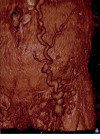A Rare Cause of Persistent Blood Loss after Continuous Ambulatory Peritoneal Dialysis Catheter Placement
- PMID: 32148997
- PMCID: PMC7054791
- DOI: 10.1155/2020/1309418
A Rare Cause of Persistent Blood Loss after Continuous Ambulatory Peritoneal Dialysis Catheter Placement
Abstract
The laparoscopic placement of a continuous ambulatory peritoneal dialysis (CAPD) catheter is a widely used method in patients with end stage renal disease (ESRD). The potential complications of this procedure include perforation of intra-abdominal organs, surgical site infection, peritonitis, catheter migration, catheter blockage, port site herniation, and bleeding. In most cases, bleeding is considered to be an early-onset complication because it mostly occurs within the first seven days after surgery. We report a case of a 68-year-old female patient with a previous history of diabetes mellitus, myelodysplastic syndrome, extensive collateral varices, anaemia, and ESRD due to obstructive uropathy caused by retroperitoneal fibrosis, who presented with persistent blood loss after the laparoscopic placement of a CAPD catheter. Duplex ultrasonography showed that the CAPD catheter was transfixing a superficial epigastric varicose vein, a collateral vein, due to the occlusion of the left external iliac vein. Persistent blood loss after inserting a CAPD catheter without previous imaging of abdominal wall vessels is an indication for further diagnostics.
Copyright © 2020 T. Natroshvili et al.
Conflict of interest statement
The authors declare that they have no conflicts of interest.
Figures


References
-
- Evangelos C. T., Siakis P., Glantzounis G., et al. Laparoscopic placement of the Tenckhoff catheter for peritoneal dialysis. Surgical Laparoscopy, Endoscopy & Percutaneous Techniques. 2000;10:218–221. - PubMed
-
- Wong L. P., Yamamoto K. T., Reddy V., et al. Patient education and care for peritoneal dialysis catheter placement: a quality improvement study. Peritoneal Dialysis International: Journal of the International Society for Peritoneal Dialysis. 2012;34:12–23. doi: 10.3747/pdi.2012.00190. - DOI - PMC - PubMed
Publication types
LinkOut - more resources
Full Text Sources

